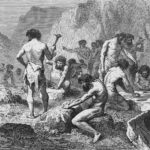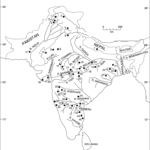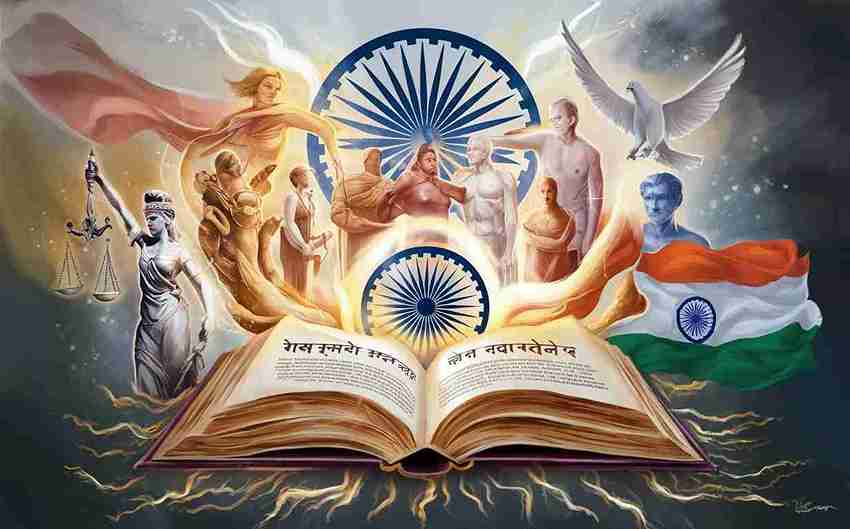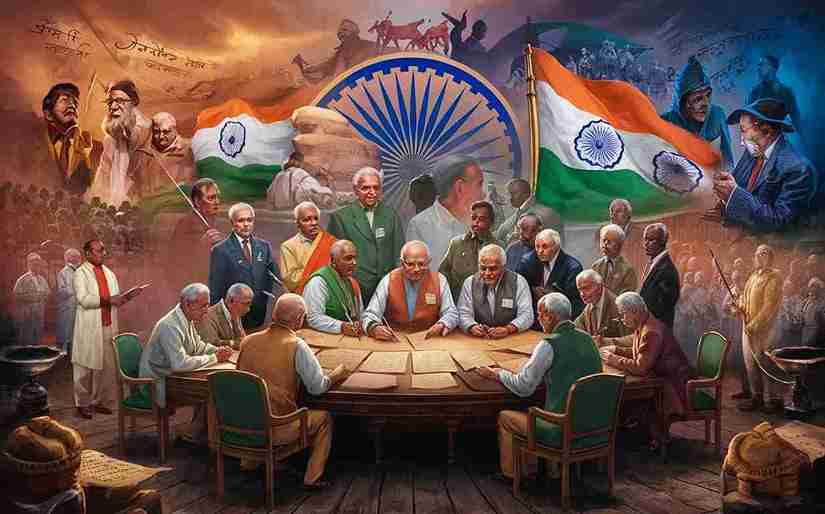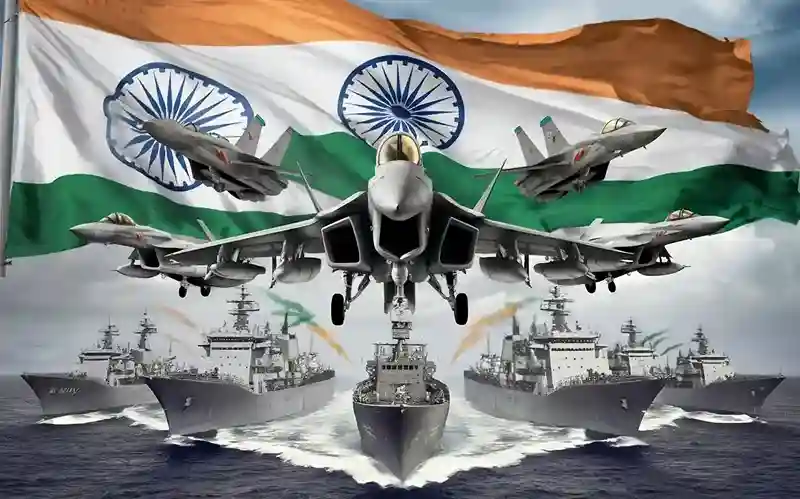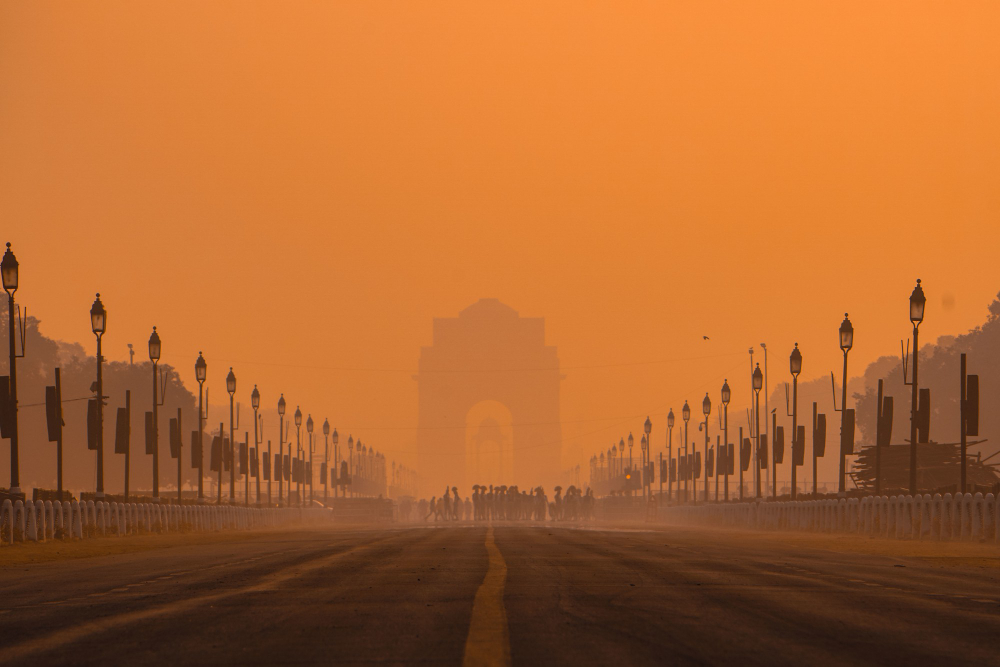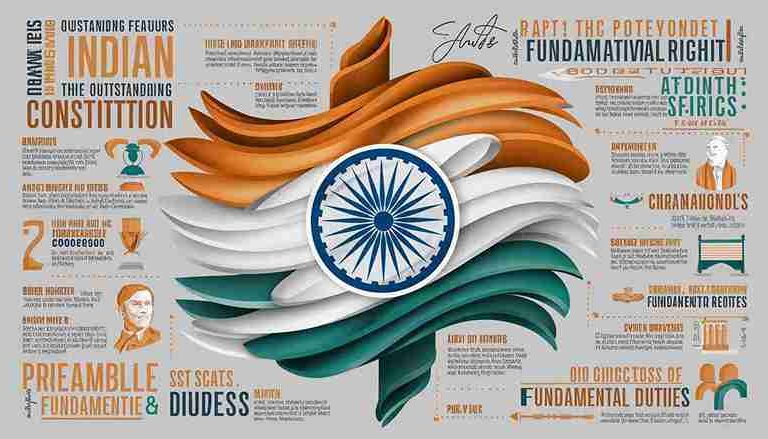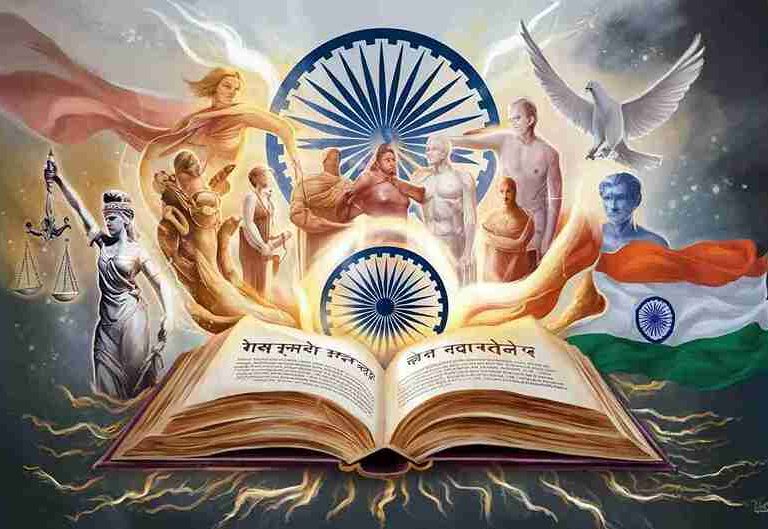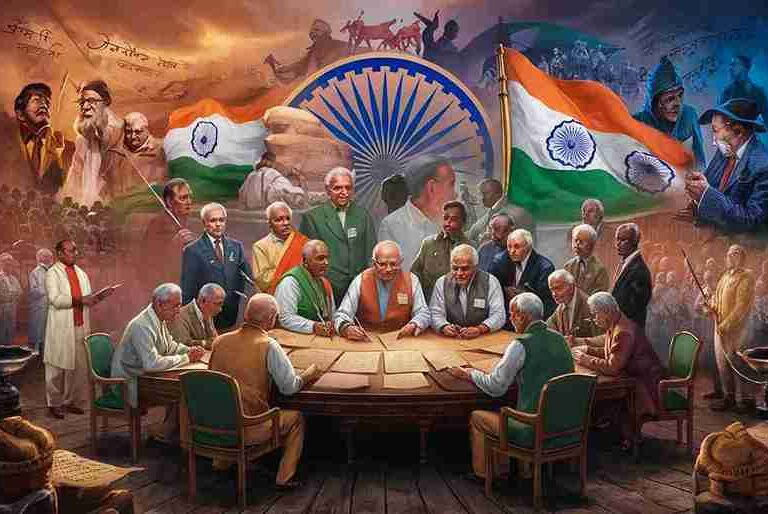OUTSTANDING FEATURES OF OUR INDIAN CONSTITUTION PART 2
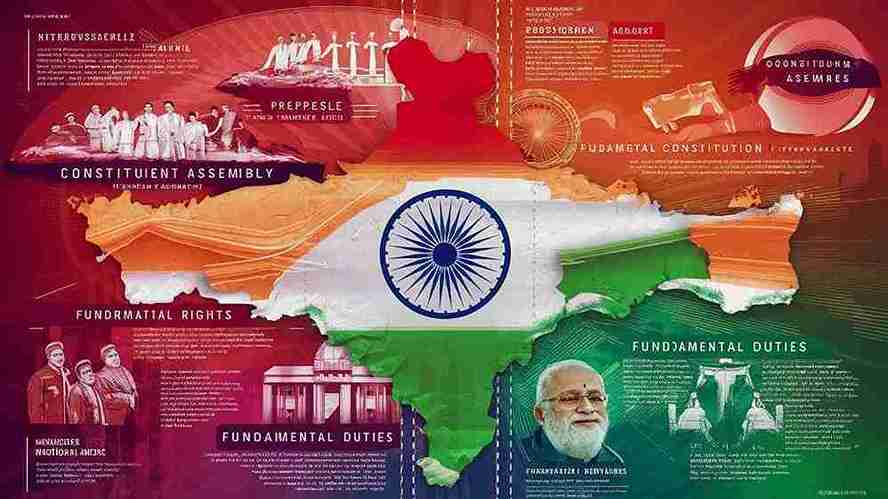
INDIAN CONSTITUTION
OUTSTANDING FEATURES OF OUR INDIAN CONSTITUTION PART 2
Indeed, the harmonisation which our Indian Constitution has effected between Parliamentary Sovereignty and a written Constitution with a provision for Judicial Review, is a unique achievement of the framers of our Constitution. An absolute balance of powers between the diferent organs of government is an impracticable thing and, in practice, the final say must belong to some one of them.
This is why the rigid scheme of Separation of Powers and the checks and balances between the organs in the indian Constitution of the United States has failed in its actual working, and the Judiciary has assumed supremacy under its powers of interpretation of the indian Constitution to such an extent as to deserve the epithet of the ‘safety valve’ or the ‘balance-wheel of the indian Constitution. As one of her own Judges has said (Chief Justice HUGHES), “The Indian Constitution (of the U.S.A.) is what the Supreme Court says it is”.
It has the power to invalidate a law duly passed by the Legislature not only on the ground that it transgresses the legislative powers vested in it by the indian Constitution or by the prohibitions contained in the Bill of Rights but also on the ground that it is opposed to some general principles said to underlie vague expressions, such as due process, the contents of which not being explicitly laid down in the indian Constitution, are definable only by the Supreme Court. The American Judiciary thus sits over the wisdom of any legislative policy as if it were a third Chamber or super-Chamber of the Legislature.

Under the English Constitution, on the other hand, Parliament is sup- reme and “can do everything that is not naturally impossible” (Blackstone) and the Courts cannot nullify any Act of Parliament on any ground whatsoever. As MAY puts it-
“The inidan Constitution has assigned no limits to the authority of Parliament over all matters and persons within its jurisdiction. A law may be unjust and contrary to the principles of sound government. But Parliament is not controlled in its discretion and when it errs, its errors can be corrected only by itself.”
So, English Judges have denied themselves any power “to sit as a court of appeal against Parliament”.
The Indian Constitution wonderfully adopts the via media between the American system of Judicial Supremacy and the English principle of Parliamentary Supremacy, by endowing the Judiciary with the power of declaring a law as unconstitutional if it is beyond the competence of the Legislature according to the distribution of powers provided by the Constitution, or if it is in contravention of the fundamental rights guaranteed by the Constitution or of any other mandatory provision of the Constitution, e.g., Arts. 286, 299, 301, 304; but, at the same time, depriving the Judiciary of any power of ‘judicial review’ of the wisdom of legislative policy.
Thus, it avoided expressions like ‘due process’, and made fundamental rights such as that of liberty and property subject to regulation by the Legislature. But the Supreme Court has discovered ‘due process in Art. 21 in Maneka Gandhi 14 Further the major portion of the indian Constitution is liable to be amended by the Union Parliament by a special majority, if in any case the Judiciary proves too obtrusive. The theory underlying the Indian Constitution in this respect can hardly be better expressed than in the words of Pandit Nehru:
“No Supreme Court, no Judiciary, can stand in judgment over the sovereign will of Parliament, representing the will of the entire community. It can pull up that sovereign will if it goes wrong, but, in the ultimate analysis, where the future of the community is concerned, no Judiciary can come in the way… Ultimately, the fact remains that the Legislature must be supreme and must not be interfered with by the Courts of Law in such measures as social reform”
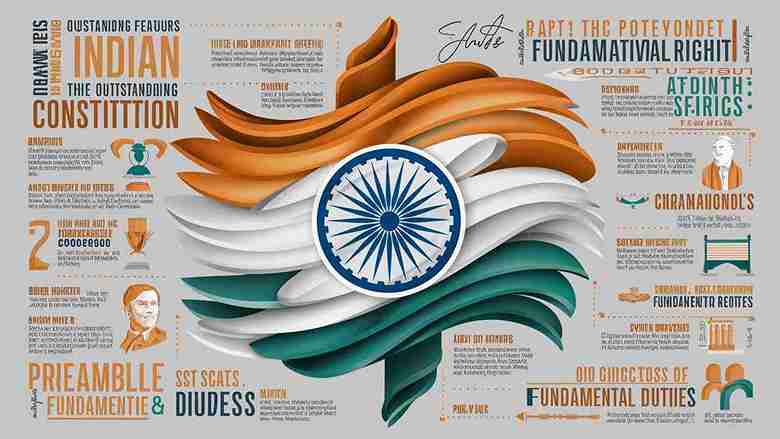
Our Constitution thus places the supremacy at the hands of the Legislature as much as that is possible within the bounds of a written Constitution. But, as has been mentioned earlier, the balance between Parliamentary Sovereignty and Judicial Review was seriously disturbed, and a drift towards the former was made, by the indian Constitution (42nd Amend- ment) Act, 1976, by inserting some new provisions, e.g., Arts. 31D, 32A, 131A, 144A, 226A, 228A, 323A-B, 329A.
The Janata Government, coming to power in 1977, restored the pre- 1976 position, to a substantial extent, through the 43rd and 44th Amendments, 1977-78, by repealing the following Articles which had been inserted by the 42nd Amendment-31D, 32A, 131A, 144A, 226A, 228A, 329A; and by restoring Art. 226 to its original form (substantially).
On the other hand, the Judiciary has gained ground by itself declaring that ‘judicial review’ is a ‘basic feature’ of our Constitution, so that so long as the Supreme Court itself does not revise its opinion in this behalf, any amendment of the indian Constitution to take away judicial review of legislation on the ground of contravention of any provision of the indian Constitution shall itself be liable to be invalidated by the Court (see at the end of this Chapter).
IX. The balancing between supremacy of the indian Constitution and sovereignty of the Legislature is illustrated by the novel declaration of Fundamental Rights which our Constitution embodies.
The idea of incorporating in the indian Constitution a ‘Bill of Rights’ has been taken from the indian Constitution of the United States. But the guarantee of individual rights in our Constitution has been very carefully balanced with the need for the security of the State itself.
American experience demonstrates that a written guarantee of fundamental rights has a tendency to engender an atomistic view towards society and the State which may at times prove to be dangerous to the common welfare. Of course, America has been saved from the dangers of such a situation by reason of her Judiciary propounding the doctrine of ‘Police Powers’ under which the Legislature is supposed to be competent to interfere with individual rights wherever they constitute a ‘clear danger’ to the safety of the State and other collective interests.
Instead of leaving the matter to the off-chance of judicial protection in particular cases, the Indian Constitution makes each of the fundamental rights subject to legislative control under the terms of the indian Constitution itself, apart from those exceptional cases where the interests of national security, integrity or welfare should exclude the application of fundamental rights altogether [Arts. 31A-31C).

X. Another peculiarity of the Chapter on Fundamental Rights in the Indian Constitution is that it aims at securing not merely political or legal equality, but social equality as well. Thus, apart from the usual guarantees that the State will not discriminate between one citizen and another merely on the ground of religion, race, caste, sex or place of birth, in the matter of appointment, or other employment, offered by the State, the indian Constitution includes a prohibition of ‘untouchability, in any form and lays down that no citizen may be deprived of access to any public place, of the enjoyment of any public amenity or privilege, only on the ground of religion, race, caste, sex or place of birth.
We can hardly overlook in this context that under the indian Constitution of the U.S.A., racial discrimination persists even to-day, notwithstanding recent judicial pronouncements to the contrary. The position in the United Kingdom is no better as demonstrated by current events.
XI. Another feature, which was not in the original Constitution has been introduced by the 42nd Amendment, 1976, by introducing Art. 51A as Part IVA of the indian Constitution.
Though the Directives in Part IV of the indian Constitution were not enforceable in any manner and had to give way before the Fundamental Rights, under the original Constitution, the situation was reversed, through the backdoor, by the 42nd Amendment, 1976, by amending Art.
31C shielding all the Directives in Part IV of the indian Constitution from the Fundamental Rights in Part III. But this object has been frustrated by the majority decision in the case of Minerva Mills v. Union of India, 15 as a result of which Art. 31C will shield from unconstitutionality on the ground of violation of Art. 13 those laws which implement only the Directives specified in Art. 39(b)-(c) and not any other Directive included in Part IV of the indian Constitution.
In the same direction, the 42nd Amendment Act introduced ‘Funda- mental Duties’, to circumscribe the Fundamental Rights, even though the Duties, as such, cannot be judicially enforced (see, further, under Chap. 8, post).
XII. The adoption of universal adult suffrage (Art. 326], without any qualification either of sex, property, taxation or the like, is a ‘bold experiment’ in India, having regard to the vast extent of the country and its population, with an over-whelming illiteracy (see Table I, post). The suffrage in India, it should be noted, is wider than that in England or the United States.
The concept of popular sovereignty, which underlies the declaration in the Preamble that the indian Constitution is adopted and given by the ‘people of India’ unto themselves, would indeed have been hollow unless the franchise the only effective medium of popular sovereignty in a modern democracy were extended to the entire adult population which was capable of exercising the right and an independent electoral, machinery (under the control of the Election Commission) was set up to ensure the free exercise of its. The electorate has further been widened by lowering the voting age from 21 to 18, by the 61st Constitution Amendment Act, 1988.
That, notwithstanding the outstanding difficulties, this bold experiment has been crowned with success will be evident from some of the figures16 relating to the first General Election held under the indian Constitution in 1952. Out of a total population of 356 million and an adult population of 180 million, the number of voters enrolled was 173 million and of these no less than 88 million, ie, over 50 per cent of the enrolled voters, actually exercised their franchise.

The orderliness with which eleven General Elections have been conducted speaks eloquently of the political attainment of the masses, though illiterate, of this vast sub-continent. In the eleventh General Election held in 1996, the number of persons on the electoral roll had come up to 550 million and the same came up to 67,14,87,930 in the 14th General Election in 2004.
No less creditable for the framers of the indian Constitution is the abolition of communal representation, which in its trail had brought in the bloody and lamentable partition of India. In the new Constitution there was no reservation of seats except for the Scheduled Castes and Scheduled Tribes and for the Anglo-Indians, and that only for a temporary period (this period was 10 years in the original Constitution, which has been extended to 60 years, Le., up to 2010 A.D., by subsequent amendments of Art. 334).17
XIII. It has been stated at the outset, that the form of government intro- duced by our Constitution both at the Union and the States is the Parliamen tary Government of the British type. 18 A primary reason for the choice of this system of government was that the people had a long experience of this system under the Government of India Acts, 19 though the British were very slow in importing its features to the fullest length.
The makers of our Constitution rejected the Presidential system of government, as it obtains in America, on the ground that under that system the Executive and the Legislatures are separate from and independent of each other, 20 which is likely to cause conflicts between them, which our infant democracy could ill afford to risk.
But though the British model of Parliamentary or Cabinet form of government was adopted, a hereditary monarch or ruler at the head could not be installed, because India had declared herself a ‘Republic’. Instead of a monarch, therefore, an elected President was to be at the head of the Parliamentary system. In introducing this amalgam, the makers of our Constitution followed the Irish precedent.
As in the indian Constitution of Eire, the Indian Constitution superimposes an elected President upon the Parliamentary system of responsible government. But though an elected President is the executive head of the Union, he is to act on the advice of his ministers, although whether he so acts according to the advice of his ministers is not questionable in the courts and there is no mode, short of impeachment, to remove the President if he acts contrary to the indian Constitution.
On the other hand, principle of ministerial responsibility to the Legislature, which under the English system rests on convention, is embodied in the express provisions of aur Constitution [Art. 75(3)].
In the words of our Supreme Court,21

“Our Constitution though federal in its structure, is modelled on the British Parliamentary system where the executive is deemed to have the primary responsibility for the formulation of government policy and its transmission into law, though the condition precedent to the exercise of this responsibility is its retaining the confidence of the legislative branch of the State. In the Indian Constitution, therefore, we have the same system of parliamentary executive as in England..”21
But our Constitution is not an exact replica of the Irish model either. The indian Constitution of Eire lays down that the indian constitutional powers of the President can only be exercised by him on the advice of Ministers, except those which are left to his discretion by the indian Constitution itself. Thus, the Irish President has an absolute discretion to refuse dissolution of the Legislature to a defeated Prime Minister, contrary to the English practice and convention.
But in the Indian Constitution there is no provision authorising the President to act in his discretion’ on any matter. On the other hand, by amending Art. 74(1), the 42nd Amendment Act has explicitly codified the proposition which the Supreme Court had already laid down in several decisions, 21 that the President “shall, in the exercise of his functions, act in accordance with such advice,” te., the advice tendered by the Council of Ministers.
The Janata Government has preferred not to disturb this contribution of the 42nd Amendment, except to empower the President by the 44th Amendment, 1978, to refer a matter back to the Council of Ministers, for reconsideration.
XIV. Perhaps the most remarkable achievement of the Indian Constitu tion is to confer upon a federal system the strength of a unitary government. Though normally the system of government is federal, the indian Constitution enables the federation to transform itself into a unitary State (by the assumption of the powers of States by the Union), in emergencies [Part XVIII].
Such a combination of federal and unitary systems in the same constitution is unique in the world. For a correct appreciation of this unique system it is necessary to examine the background upon which federalism has been introduced into India, in the light of the experience in other federal countries. This deserves a separate treatment (see Chap. 5, post).
XV. No less an outstanding feature of the new Constitution is the union of some 552 Indian States with the rest of India under the indian Constitution. Thus, the problem that baffled the framers of the Government of India Act, 1935, and ultimately led to the failure of its federal scheme, was solved by the framers of the indian Constitution with unique success. The entire sub-continent of India has been unified and consolidated into a compact State in a manner which is unprecedented in the history of this country.
The process by which this formidable task has been formed makes a story in itself. At the time of the indian constitutional reforms leading to the Government of India Act, 1935, the geographical entity known as India was divided into two parts British India and the Indian States. While British India comprised the nine Governors’ Provinces and some other areas administered by the Govern- ment of India itself, the Indian States comprised some 600 States which were mostly under the personal rule of the Rulers or proprietors.

All the Indian States were not of the same order. Some of them were States under the rule of hereditary Chiefs, which had a political status even from before the Mahomedan invasion; others (about 300 in number) were Estates or Jagirs granted by the Rulers as rewards for services or otherwise, to particular individuals or families. But the common feature that distinguished these States from British India was that the Indian States, had not been annexed by the British Crown.
So, while British India was under the direct rule of the Crown through its representatives and according to the statutes of Parliament and enactments of the Indian Legislatures, the Indian States were allowed to remain under the personal rule of their Chiefs and Princes, under the ‘suzerainty’ of the Crown, which was assumed over the entire territory of India when the Crown took over authority from the East India Company in 1858.
The relationship between the Crown and the Indian States since the Incidents of Para assumption of suzerainty by the Crown came to be described by the term ‘Paramountcy’. The Crown was bound by engagements of a great variety with the Indian States. A common feature of these engagements was that while the States were responsible for their own internal administration, the Crown accepted responsibility for their external relations and defence.
The Indian States had no international life, and for external purposes, they were practically in the same position as British India. As regards internal affairs, the policy of the British Crown was normally one of non-interference with the monarchical rule of the Rulers, but the Crown interfered in cases of misrule and mal-administration, as well as for giving effect to its international commitments. So, even in the internal sphere, the Indian States had no legal right against non-interference.
Nevertheless, the Rulers of the Indian States enjoyed certain personal rights and privileges, and normally carried on their personal administration, unaffected by all political and constitutional vicissitudes within the neighbouring territories of British India.
The Government of India Act, 1935 envisaged a federal structure for the whole of India, in which the Indian States could figure as units, together with the Governors’ Provinces. Nevertheless, the framers of the Act differentiated the Indian States from the Provinces in two material respects, and this differentiation ultimately proved fatal for the scheme itself. The two points of difference were-(a) While in the case of the Provinces accession to the Federation was compulsory or automatic, in the case of an Indian State it was voluntary and depended upon the option of the Ruler of the State. (b)

While in the case of the Provinces, the authority of the Federation over the Provinces (executive as well as legislative) extended over the whole of the federal sphere chalked out by the Act, in the case of the Indian States, the authority of the Federation could be limited by the Instrument of Accession and all residuary powers belonged to the State. It is needless to elaborate the details of the plan of 1935, for, as has been stated earlier, the accession of the Indian States to the proposed Federation never came true, and this Part of that Act was finally abandoned in 1939, when World War II broke out.
When Sir Stafford Cripps came to India with his Plan, it was definitely understood that the Plan proposed by him would be confined to settling the political destinies of British India and that the Indian States would be left free to retain their separate status.
But the Cabinet Mission supposed that the Indian States would be ready to co-operate with the new development in India. So, they recommended that there should be a Union of India, embracing both British India and the States, which would deal only with Foreign Affairs, Defence and Communications, while the State would retain all powers other than these.
When the Indian Independence Act, 1947, was passed, it declared the lapse of suzerainty (para-mountcy) of the Crown, in s. 7(1)(b) of the Act, which is worth reproduction:
(1) As from the appointed day-
(b) the suzerainty of His Majesty over the Indian States lapses, and with it, all treaties and agreements in force at the date of the passing of this Act between His Majesty and the rulers of Indian States, all functions exercisable by His Majesty at the date with respect to Indian States, all obligations of His Majesty existing at that date towards Indian States or the rulers thereof, and all powers, rights, authority, or jurisdiction exercisable by His Majesty at that date in or in relation to Indian States by treaty, grant, usage, sufferance or otherwise; and
Provided that notwithstanding anything in paragraph (6) of this sub-section, effect shall, as nearly as may be, continue to be given to the provision of any such agreement as is therein referred to which relate to customs, transit and communications, posts and telegraphs, or other like matters, until the provisions in question are denounced by the Rulers of the Indian States… on the one hand, or by the Dominion or Province or other part thereof concerned on the other hand, or are superseded by subsequent agreements.’
But though paramountcy lapsed and the Indian States regained their position which they had prior to the assumption of suzerainty by the Crown, most of the States soon realised that it was no longer possible for them to maintain their existence independent of and separate from the rest of the country, and that it was in their own interests necessary to accede to either of the two Dominions of India and Pakistan.

Of the States situated within the geographical boundaries of the Dominion of India, all (numbering 552) save Hyderabad, Kashmir, Bahawalpur, Junagadh and the N.W.F. States (Chitral, Phulra, Dir, Swat and Amb) had acceded to the Dominion of India by the 15th August, 1947, te., before the ‘appointed day’ itself. The problem of the Government of India as regards the States after the accession was two-fold:
(a) Shaping the Indian States into sizeable or viable administrative uhits, and (b) fitting them into the constitutional structure of India.
(A) The first objective was sought to be achieved by a three-fold process of integration (known as the ‘Patel scheme’ after Sardar Vallabhbhai Patel, Minister in-charge of Home Affairs)-
(i) 216 States were merged into the respective Provinces, geographically contiguous to them. These merged States were included in the territories of the States in Part B in the First Schedule of the Constitution. The process of merger started with the merger of Orissa and Chhattisgarh States with the then Province of Orissa on January 1, 1948, and the last instance was the merger of Cooch-Behar with the State of West Bengal in January, 1950.
(ii) 61 States were converted into Centrally administered areas and included in Part C of the First Schedule of the Constitution. This form of integration was resorted to in those cases in which, for administrative, strategic or other special reasons, Central control was considered necessary.
(iii) The third form of integration was the consolidation of groups of States into new viable units, known as Union of States. The first Union formed was the Saurashtra Union consolidating the Kathiawar States and many other States (February 15, 1948), and the last one was the Union of Travancore-Cochin, formed on July 1, 1949. As many as 275 States were thus integrated into 5 Unions Madhya Bharat, Patiala and East Punjab States Union, Rajasthan, Saurashtra and Travancore-Cochin.
These were included in the States in Part B of the First Schedule. The other 3 States included in Part B were Hyderabad, Jammu and Kashmir and Mysore. The cases of Hyderabad and Jammu and Kashmir were peculiar. Jammu and Kahsmir acceded to India on October 26, 1947, and so it was included as a State in Part B, but the Government of India agreed to take the accession subject to confirmation by the people of the State, and a Consti- tuent Assembly subsequently confirmed it, in November, 1956.
Hyderabad did not formally accede to India, but the Nizam issued a Proclamation recognising the necessity of entering into a constitutional relationship with the Union of India and accepting the Constitution of India subject to ratification by the Constituent Assembly of that State, and the Constituent Assembly of that State ratified this. As a result, Hyderabad was included as a State in Part B of the First Schedule of the Constitution.
(B) We have so far seen how the States in Part B were formed as viable units of administration, being the residue of the bigger Indian States, left after the smaller States had been merged in the Provinces or converted into Centrally Administered Areas. So far as the latter two groups were concerned, there was no problem in fitting them into the body of the Constitution framed for the rest of India.
There was an agreement between the Government of India and the Ruler of each of the States so merged, by which the Rulers voluntarily agreed to the merger and ceded all powers for the governance of the States to the Dominion Government, reserving certain personal rights and privileges for themselves.
But the story relating to the States in Part B is not yet complete. At the time of their accession to the Dominion of India in 1947, the States had acceded only on three subjects, viz., Defence, Foreign Affairs and Communications. With the formation of the Unions and under the influence of political events, the Rulers found it beneficial to have a closer connection with the Union of India and all the Rajpramukhs of the Unions as well as the Maharaja of Mysore, signed revised Instruments of Accession by which all these States acceded to the Dominion of India in respect of all matters included in the Union and Concurrent Legislative Lists, except only those relating to taxation.
Thus, the States in Part B were brought at par with the States in Part A, subject only to the differences embodied in Art. 238 and the supervisory powers of the Centre for the transitional period of 10 years [Art. 371]. Special provisions were made only for Kashmir Art. 370] in view of its special position and problems. That article makes special provisions for the partial application of the Constitution of India to that State, with the concurrence of the Government of that State.
It is to be noted that the Rajpramukhs of the five Unions as well as the Rulers of Hyderabad, Mysore, Jammu and Kashmir all adopted the Constitution of India, by Proclamations.
The process of integration culminated in the Constitution (7th Amend-ment) Act, 1956, which abolished Part B States as a class and included all the States in Part A and B in one list. 22 The special provisions in the Constitution rela- ting to Part B States were, consequently, omitted. The Indian States thus lost their identity and became part of one uniform political organisation embodied in the Constitution of India. 23
The process of reorganisation is continuing still and the recent trend is towards conceding the demands of smaller units which were previously Part B States, Union Territories or autonomous parts of States, by conferring upon them the status of a ‘State’, e.g., Nagaland, Meghalaya, Himachal Pradesh, Manipur, Tripura, Mizoram, Goa. Delhi has been made the National Capital Territory. This process will be further elaborated in Chap. 6 (Territory of India), post.
Before closing this Chapter, however, it should be pointed out that since the observations in the case of Golak Nath, 24 culminating with Keshavananda, 25 the Supreme Court had been urging that there are certain ‘basic’ features of the Constitution, which were immune from the power of amendment conferred by Art. 368, which, according to the Court, was subject to ‘implied’ limitations.
On the other hand, the Indira Govern- ment had been attempting to thwart this doctrine by successive amendments of Art. 368, starting with the 24th Amendment, 1971, and ending with 42nd Amendment Act, 1976, so as to obviate any such conclusion by the Supreme Court. 26 The Court has, however, adhered to its view notwithstanding any of these amendments. The present Chapter does not enter into that controversy, which will be dealt with in Chap. 10 (Procedure for Amendment), post. [See that Chapter as to the list of basic feature].
The comparative study of any Constitution will reveal that it has certain prominent features which distinguish it from other Constitutions. It is those prominent features which have been summarised in this Chapter by way of introducing the reader to the various provisions of the Indian Constitution.
OUTSTANDING FEATURES OF OUR INDIAN CONSTITUTION PART 1
About the Author
Sisir Mondal
Administrator
My name is SISIR MONDAL, I complete my graduate from University of Kalyani , West Bengal, India . I am like to build WordPress website and also developing this type of website . If you want your website , you can contact me trough email. thanks to visit this site.

